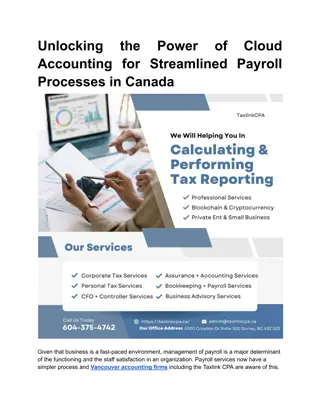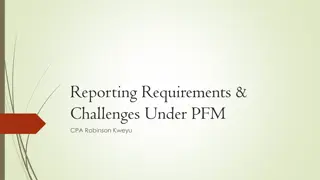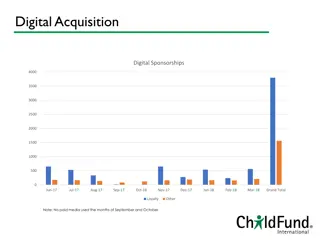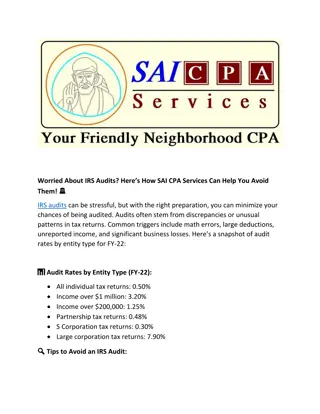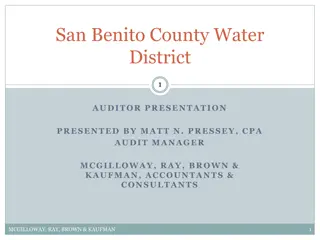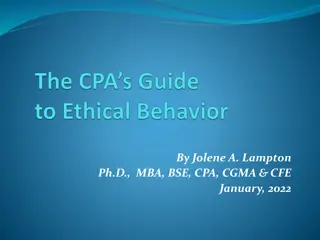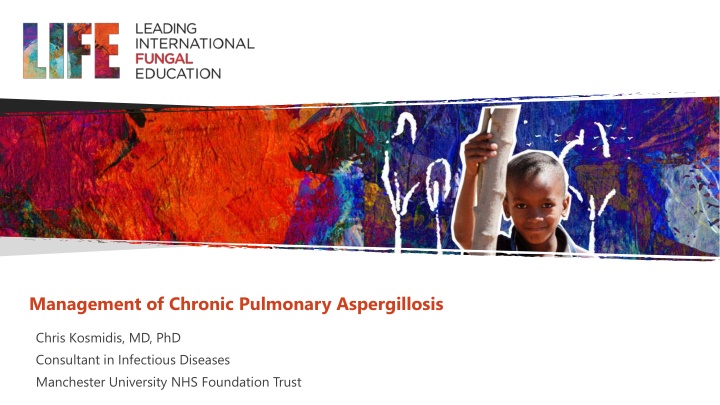
Chronic Pulmonary Aspergillosis Management Guidelines
Learn about the medical management principles of chronic pulmonary aspergillosis (CPA) including the use of oral azole therapy, intravenous antifungals, monitoring for azole resistance, and minimizing lung infection risk factors. Understand the objectives of antifungal therapy and the importance of early intervention to prevent complications in CPA patients.
Download Presentation

Please find below an Image/Link to download the presentation.
The content on the website is provided AS IS for your information and personal use only. It may not be sold, licensed, or shared on other websites without obtaining consent from the author. If you encounter any issues during the download, it is possible that the publisher has removed the file from their server.
You are allowed to download the files provided on this website for personal or commercial use, subject to the condition that they are used lawfully. All files are the property of their respective owners.
The content on the website is provided AS IS for your information and personal use only. It may not be sold, licensed, or shared on other websites without obtaining consent from the author.
E N D
Presentation Transcript
Management of Chronic Pulmonary Aspergillosis Chris Kosmidis, MD, PhD Consultant in Infectious Diseases Manchester University NHS Foundation Trust
Intended Learning Outcomes To be aware of the medical management of chronic pulmonary aspergillosis To understand the role and indications of intravenous antifungals in the management of CPA To be aware of the prognosis and predictors of poor outcomes in CPA
Principles of CPA management Oral azole therapy is key Therapy is long-term as relapse is common off therapy Itraconazole, voriconazole and posaconazole all effective Major drug interactions and common, serious side effects drug level monitoring recommended IV Amphotericin B or echinocandins useful for failure of oral azole therapy Interferon-gamma supplementation helpful in some cases Some patients appear not to progress, but should to be kept under observation, as progression may be subclinical Minimise other causes of lung infection with immunisation and antibiotics Withdraw or minimise immunosuppressive drugs wherever possible, including inhaled steroids Monitor for azole resistance
Management of CPA CPA entity Initial therapy Duration Alternative therapy None Cautions Simple aspergilloma Aspergillus nodule Surgical resection .. Sufficient respiratory reserve, relapse is possible If multiple, continued imaging and possibly repeat biopsy if progressive Drug interactions, especially rifampicin; long-term toxicity include peripheral neuropathy and skin photosensitivity (voriconazole) None, if asymptomatic .. Azole therapy, if progressive Chronic cavitary and fibrosing CPA Itraconazole or voriconazole >6 months , typically long-term Posaconazole, Isavuconazole, liposomal amphotericin B, echinocandins Denning & Chakrabarti Lancet Infect Dis. 2017: S1473-3099(17)30309-2.
Objectives of antifungal therapy Very ill patients: Save their lives with (usually) IV and then oral therapy Quite ill patients: Improve quality of life by minimising symptoms Prevent further haemoptysis (coughing blood) Stop progression of scarring in the lung Prevent the emergence of antifungal resistance Avoid antifungal toxicity Patients with few symptoms or asymptomatic Stop progression of scarring in the lung Prevent the emergence of antifungal resistance Avoid antifungal toxicity Regression of Aspergilloma on treatment September , 2016 No Aspergilloma September , 2013 Aspergilloma
CPA management framework Itraconazole Voriconazole Key challenges Antifungal resistance Adverse events Drug-drug interactions Posaconazole Isavuconazole IV Amphoterin B or echinocandins
Response rate to antifungal therapy Itraconazole: 76.5% [6 mo]1 Voriconazole: 64% (3 mo )2, 32 % (6 mo)3 Posaconazole: 61% [6mo] vs 46% [12 mo]4 1Agarwal et al. Mycoses. 2013 Sep; 56(5):559-70 2Jain et al. J Infect. 2006 May; 52(5):e133-7. 3Cadranel et al . Eur J Clin Microbiol Infect Dis. 2012 Nov;31(11):3231-9. 4Felton et al. Clin Infect Dis. 2010 Dec 15;51(12):1383-91.
Response rate to antifungal therapy Micafungin and Voriconazole for CPA Response rate at 2-12 weeks Caspofungin: 47% Micafungin: 42% Micafungin and Voriconazole for CPA Response rate at 2 weeks Micafungin: 68% Voriconazole: 59% Response rate at 4 weeks Micafungin: 60% Voriconazole: 53% Kohno et al. J. Infect. 2010;61:410-8. Kohno et al. Eur J Clin Microbiol Infect Dis. 2013;32:387-97.
Itraconazole randomised clinical trial Standard care 6 mo 12 mo Oral itraconazole 6 mo 12 mo 35% Improved 24% 7% 7% 21% 41% 24% Stable 29% 23% Deterioration 64% 53% Natural history with no therapy over 12 months 71% 30% relapse off therapy in 6 months Agarwal R, et al, Mycoses. 2013 56:559-70.
Intravenous antifungals for CPA Amphotericin B or echinocandins Short-term course (2-4 weeks) Useful initial therapy in severe disease Symptomatic benefit may persist for weeks / months after completing course 3 4 courses per year can be given as a long term management option Indications: Progressive disease Treatment failure on oral azoles Intolerance to triazoles Pan-azole resistance Infection control strategy (IV induction followed by an oral maintenance therapy ) Kohno et al J Infect 2010; 61: 410 418.
Outcome (survival) of treated CPA 86% 62% 47% 1 Year 5 Years 10 Years Lowes et alEur Respir J. 2017;49:pii: 1601062
Recurrence (relapse) of CPA Relapse of CPA symptoms are common following discontinuation of long-term maintenance therapy. Relapse can be:- Clinical Worsening of clinical manifestations Radiological Enlargement of fungal balls or pre-existing cavities Serological Rising Aspergillus IgG titres Microbiological Strong PCR signals, culture positivity
Recurrence of CPA Predictors 1. 2. 3. After medical treatment Younger age Bilateral or multilobar CPA disease Longer antifungal treatment duration 41% (India) Agarwal et al. 2013 36% (Japan) Koyama et al 2014 17% (France) Cadranel et al 2012 11% (Italy) Cucchetto et al 2015 Post-surgical relapse Agarwal et al. Mycoses. 2013;56:559 70. Koyama et al. J Infect Chemother. 2014;20:375 9 Cadranel et al. Eur J Clin Microbiol Infect Dis. 2012;31:3231 9 Cucchetto et al. Infection. 2015;43:277 86. Farid et al J Cardiothorac Surg .2013;8:180. Lee et al. J Thorac Cardiovasc Surg . 2009;138:820 5 26% (UK) Farid et al 2013 3.9% (Seoul, S. Korea) Lee et al 2009
Prognostic factors Increased mortality is associated with:- Low body mass index NTM co-infection Underlying COPD Higher age Lower albumin Lower activity score in the St. George's Quality of Life score Bilateral aspergilloma >>aspergilloma Lowes et alEur Respir J. 2017;49. pii: 1601062.
Summary Long-term oral triazole therapy is the mainstay for the management of chronic pulmonary aspergillosis Itraconazole, voriconazole and posaconazole are all effective IV Amphotericin B or echinocandins useful after failure of oral azole therapy Relapse of CPA symptoms are common following discontinuation of long-term maintenance therapy




